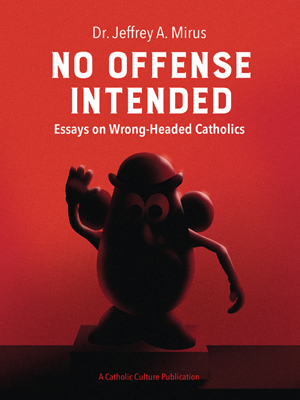Benedict’s Second Volume and the Historical Critical Method
By Dr. Jeff Mirus ( bio - articles - email ) | Mar 24, 2011
Jesus of Nazareth Part II is out, and I’m working my way through it, not only to pass along the highlights but for spiritual reading. The Pope’s first volume (see Benedict’s New Book, The “Our Father” according to Benedict, and A Final Note on Benedict’s Jesus of Nazareth) was a luminous and spiritually rich commentary on the person of Christ. This second volume focuses on Our Lord’s salvific mission from His entrance into Jerusalem to the Resurrection: in other words, Holy Week.
Historical Criticism
But the very first nugget which caught my attention in a book sure to be characterized by a rich vein of gold is the Pope’s comments on historical criticism in his Foreword. After all, the Pope’s project in this two-volume work is to recover a full awareness of the person of Jesus, a project necessitated in part by the mangled and fragmented portrait left over after the historical-critical method of Scriptural exegesis that has dominated the past two hundred years. Indeed, in the Foreword to the first volume, Benedict had written:
Historical-critical interpretation of a text seeks to discover the precise sense the words intended to convey at their time and place of origin…. [But] it is important to keep in mind that any human utterance of a certain weight contains more than the author may have been immediately aware of at the time…. At this point we get a glimmer, even on the historical level, of what inspiration means: The author does not speak as a private, self-contained subject. He speaks in a living community…which is led forward by a greater power that is at work…. Neither the individual books of Holy Scripture nor the Scripture as a whole are simply a piece of literature. The Scripture emerged from within the heart of a living subject—the pilgrim People of God—and lives within this same subject…. [And] likewise, this people does not exist alone; rather, it knows that it is led, and spoken to, by God himself, who—through men and their humanity—is at the deepest level the one speaking.
I’ve risked a long quotation here—though vastly condensed from the original, as suggested by the frequent ellipses—because it sets the stage so beautifully for what the Pope says in the Foreword of his second volume. I’ll get to that in just a moment, but first let’s take a brief look at what the reign of historical criticism has meant. We’ll do this by taking just one example.
One Example
Recently most right-thinking Catholics (by which of course I mean Catholics whose conclusions mirror my own!) were annoyed to learn that the latest translation of the New American Bible has replaced the word “virgin” with “young woman” in Isaiah 7:14: “The virgin shall be with child, and bear a son, and shall name him Immanuel.” The passage is cited in St. Matthew in reference to the virgin birth of Our Lord (Mt 1:23).
Now there is some grounds for this change. The word “almah” in Hebrew can mean a young, unmarried woman in a rather generic sense, or it can mean more specifically a virgin. But generally in the Old Testament, when “virgin” is unambiguously intended, a different and more precise word is used, such as “betulah”. The exegete who approaches this text exclusively from the historical-critical point of view argues that Isaiah, in his own time and place, could not have had the birth of Christ in mind. Rather, the problem with which he was directly concerned was the siege of Jerusalem by the combined armies of Syria and the Northern Kingdom around 735 BC. The conception of a child by a young woman was to be a sign that the siege would be lifted and Jerusalem would continue to flourish.
And that’s as far as the historical-critical method can take us, working alone and in isolation from other interpretive insights. So those who rely exclusively on this method assert that this text of Isaiah was fulfilled over seven hundred years before the birth of Christ and has nothing to do with Our Lord at all. Moreover, St. Matthew was clearly wrong, on the basis of the historical-critical method, to appropriate the text as he did.
The True Nature of Scripture
You can see, therefore, why in his first volume, in discussing his own exegetical methods, Pope Benedict stresses that each portion of Scripture must be read in the context of the whole, and that each Scriptural passage is pregnant with meaning because its authorship is rooted in a community actively inspired and led by God according to His own Providential plan. Thus an early prophecy by Isaiah can operate at multiple levels, with one clear application in Isaiah’s own time, and another that becomes clear only later. And St. Matthew is perfectly justified in appropriating this more distant and deeper meaning to Christ, in whom all of Scripture finds its goal and unity.
What, then, does historical criticism do for us? Does it have any value at all? Actually, yes, because the more we know about the circumstances in which a particular passage was written, and about the immediate application of that passage, the richer is our understanding of the many ways in which that particular set of circumstances suggests a moral or a spiritual lesson, or foreshadows later developments, or otherwise illuminates God’s saving action at multiple levels throughout history. To understand the historical context of Isaiah’s utterance is to understand more thoroughly God’s salvific power—His ability to prefigure the work of His Son not only in words but in historical events—just as the historical details of the Exodus foreshadow and enrich our understanding of what it means for Christ to save us from sin.
But to lock ourselves within the historical-critical method, as if each passage must be limited to what was naturally evident at the time it was recorded, is to deny not only the implications of the Sacred text in the communitarian tradition but also the revelatory presence of God in the life of the community, as well as the supernatural agency at work in Biblical inspiration. To put this in a single word, an excessive reliance on historical criticism denies not only the importance but the very existence of theology.
In the Hands of Pope Benedict
Benedict himself explores a variety of exegetical insights starting in the very first chapter of his new volume, when he unpacks the meaning of the cleansing of the Temple. In so doing, he begins immediately to reveal the great depth of his appreciation of the person of Christ as Savior. He explores the historical situation, and finds that it resonates with other elements in the history of the Jewish people, elements which already invest the text with a power beyond its literal meaning. But the Pope is always open as well to the presence of God in this history, and of course to God fulfilling this history in the work of His only begotten Son.
All of this provides the context for the very first gold nugget Benedict offers in the Foreword to the second volume, where he continues the comments on the historical-critical method quoted above:
One thing is clear to me: in two hundred years of exegetical work, historical-critical exegesis has already yielded its essential fruit. If scholarly exegesis is not to exhaust itself in constantly new hypotheses, becoming theologically irrelevant, it must take a methodological step forward and see itself once again as a theological discipline, without abandoning its historical character. It must learn that the positivistic hermeneutic on which it has been based does not constitute the only valid and definitively evolved rational approach; rather, it constitutes a specific and historically conditioned form of rationality that is both open to correction and completion and in need of it.
Following this comment, Benedict mentions that a particular Catholic theologian (whose unfortunate name the Pope kindly omits) labeled his book a Christology from above, “not without issuing a warning about the dangers inherent in such an approach.” But it is precisely Benedict’s point that God works in and through a community, so that His presence and His action is not only above, but below and even within, a presence which cannot be ignored without reducing the Biblical text to something less than it really is.
Renewed Methodology, Renewed Faith
What the Pope calls for is “a properly developed faith-hermeneutic” as “appropriate to the text”, which “can be combined with a historical hermeneutic, aware of its limits, so as to form a methodological whole.” He states that this is “an art that needs to be constantly remastered”, and he does not “presume to claim that this combination of the two hermeneutics is already fully accomplished in my book.” Rather, he hopes his book is a significant step in the right direction. He concludes on this important point:
Fundamentally this is a matter of finally putting into practice the methodological principles formulated for exegesis by the Second Vatican Council (in Dei Verbum 12), a task that unfortunately has scarcely been attempted thus far.
Those who follow Pope Benedict’s lead in this—and there is growing evidence of such a movement already in progress—will effect a true renaissance in the study of the Word of God. In this way, Scripture will live once again as the living text of the people of God—that is, it will become once again what it was always intended by God to be, the Book of the Church.
All comments are moderated. To lighten our editing burden, only current donors are allowed to Sound Off. If you are a current donor, log in to see the comment form; otherwise please support our work, and Sound Off!
-
Posted by: Randal Mandock -
Jun. 16, 2018 11:00 AM ET USA
"The first rule in this process is that truth is the mind’s conformity with reality...Everything else is what we call destructive behavior. ...When people pull their convictions out of thin air, Catholics need to call them on it and challenge them with the reality of reality itself...a service of love." You have captured the essence of the meaning of "Church Militant" and the Sacrament of Confirmation: we Confirmed have the solemn duty by God to bring all people to recognize the reality that is.
-
Posted by: timothy.op -
Jun. 14, 2018 11:41 PM ET USA
Thank you for this cogent assessment of the losing strategy we too often pursue and your compelling account of the only truly viable alternative. Superbly stated. Robert George makes a similar point here: https://www.firstthings.com/web-exclusives/2018/06/solzhenitsyns-prophecy
-
Posted by: paul20105493 -
Mar. 29, 2011 5:11 PM ET USA
Thank you for this very clear explanation of the application and the proper role of the Historical Critical Method. Also, I was looking forward to buying a copy of the new translation of the New American Bible... until I heard about the virgin reference in Isaiah. I then decided that I don't need it after all. My RSV and older NAB will do just fine, thank you very much.
-
Posted by: -
Mar. 26, 2011 4:34 PM ET USA
Wonderful! Thank you.








